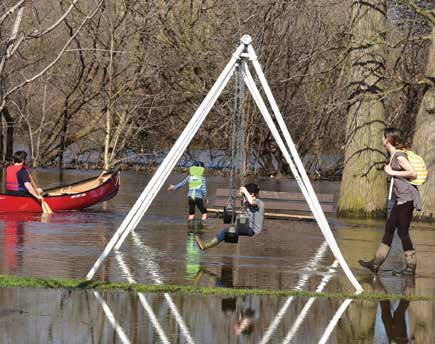Peter Croal
Old Ottawa East (OOE) is an incredible place to live. It has the best characteristics of a liveable neighbourhood: close to services, trees, green spaces, and vibrant community energy. These characteristics are at risk (especially the loss of tree canopy) if OOE does not pay attention to Ottawa’s newly approved Official Plan.

The new Official Plan states that all future development should be climate- and environmentally-friendly, but not everyone is optimistic that future actions will track these words. Photo by Peter Croal
Ontario cities are required to develop an Official Plan (OP) every 25 years, and Ottawa has not had a new one since 2003. Many cities develop OPs that are easy to understand and implement, but this is not the case for Ottawa. A draft OP was released in 2019. Since then, the draft has been revised after much community involvement and was finally approved by Council on October 27.
The importance of Ottawa’s OP cannot be understated. Ottawa will grow by 400,000 people and 195,000 homes in the next 25 years. The OP will guide how and where we build our homes and businesses and transport ourselves. Will our community intensify in a gradual way with attractive additions to existing housing and low-rise units that allow OOE to continue to be liveable, healthy and sustainable? The OP is not clear on these concerns.
The OP is framed around “5 Big Ideas”: Growth, Mobility, Urban Design, Resiliency and Economy. In submissions to the City, members of our community stated that tree canopy, climate change, neighbourhood boundaries, COVID-19 and housing were important issues for the new OP. The OP aims to have an overall 40% tree canopy, but this is not guaranteed for each ward. Intensification could occur at hubs and along road corridors, which will create “urban canyons.” Non-enforceable language, such as “could,” is commonly used. The draft OP indicated that development would be “restricted” if biodiversity was threatened. The approved OP states that development should be “avoided” if biodiversity is at risk. “Spot zoning,” Which allows for development not consistent with the OP, will also be allowed to happen.
The concerns expressed by OOE residents are found in the City’s OP consultation report called “As We Heard It”, which has an issues report for Capital Ward 17.
Sadly, the OP is a “brick” – dense, vague, contradictory and difficult to understand. It is over 250 pages, not including hundreds of pages of annexes, maps, secondary plans and attachments.
The OP has provisions to ensure that Ottawa becomes diverse, healthy, and has walkable and cyclable neighbourhoods. The OP also emphasizes a need to minimize urban sprawl, and that all future development be climate- and environment-friendly. It emphasizes the need for 15 Minute Neighbourhoods.
These aspirations are noteworthy, but the OP still:
• neglects details about urban development changes;
• aims to achieve energy retrofits for 325,000 homes but has no specifications for green standards for small low-rise developments;
• has no provisions for climate objectives on emissions in the High-Performance Development Standard, which is only applicable to high rises; and
• does not account for the effects of COVID-19 on transportation, housing and infrastructure.
OOE must have balanced growth guided by community involvement to ensure OOE is a more walkable and liveable community. The current OP does not provide clear policy direction for this, further jeopardizing our overall climate change and tree canopy efforts.
A Climate Change Master Plan was approved by City Council that identifies targets for reducing greenhouse gas emissions to zero by 2050. However, the OP lacks policies and guidelines to align urban development with greenhouse gas emission targets related to zoning and by-laws. The new OP does require the City to report on the impact of intensification on GHG emissions.
OOE residents can better understand OP issues by referring to the People’s Official Plan (POP), which is an alliance of over 20 local community organizations. The alliance has been working since 2019 to shape the OP, and foremost among its conclusions are that the OP does not effectively address the Climate Emergency, and that community consultation has been weak. POP developed eight summaries of the OP issues, which can be found at: https://www.ottawaclimatesolutions.net/. Sustainable Living Ottawa East (SLOE https://ottawaeast.ca/sloe)
has also been very active to ensure OOE residents’ views on community development are heard by the City.
OOE is a dynamic, beautiful and engaged community. To remain so, we must advocate for: official tree canopy targets for each neighbourhood; diverse and vibrant businesses on Main Street; more affordable housing; and restrictions on “spot zoning”. We have many community-building opportunities to ensure OOE continues to be a wonderful place to live for generations by being connected to Ottawa’s planning and approval processes. To explore engagement and support opportunities, please contact SLOE at sloe@ottawaeast.ca.






